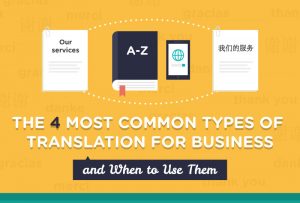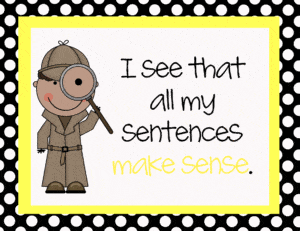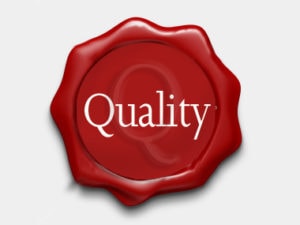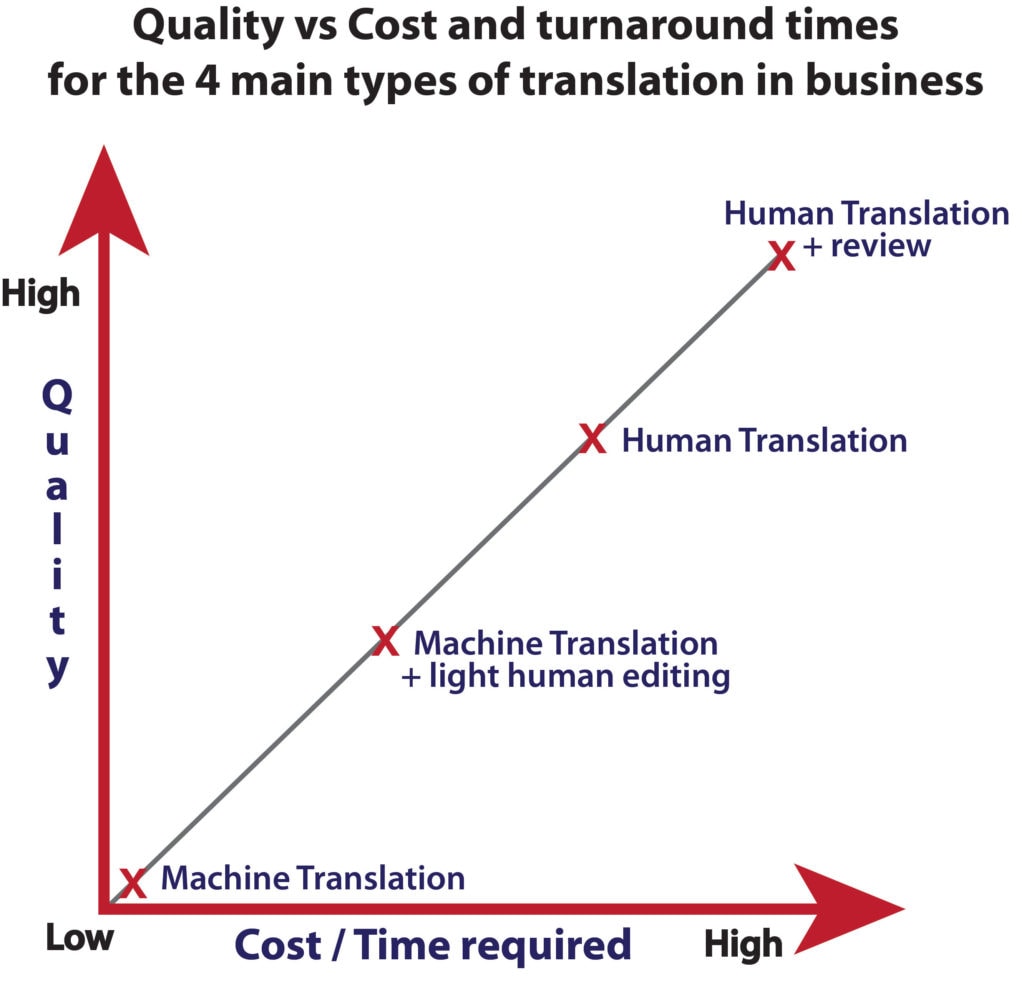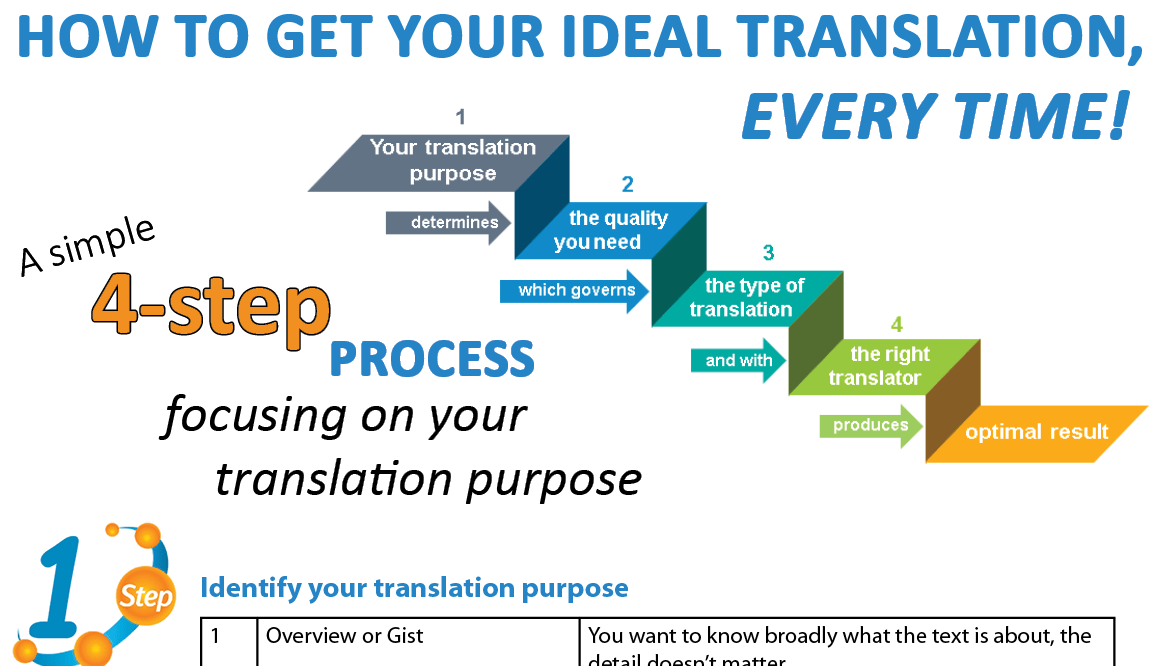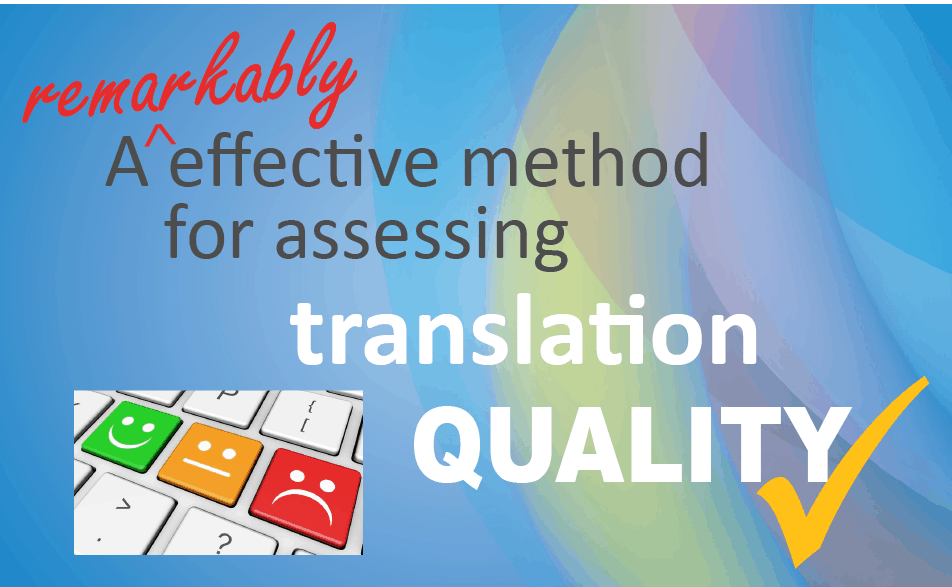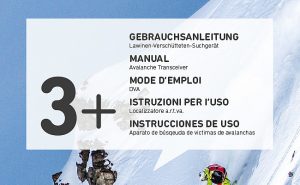There are 4 main translation methods used in business today.
And you need to know about them.
That’s because they produce very different outcomes in terms of translation quality, turnaround time and cost.
So choose the wrong one, and you may not get a translation that’s fit for purpose.
This article describes each of the methods, explains their strengths and weaknesses, and identifies what types of project and translation purposes they’re best suited for.
Don’t miss our free summary pdf download later in the article!
– Machine Translation (MT)
– Machine Translation plus human revision
– Human translation
– Human translation plus revision
Note: this article is about the practical methods used by translation providers today. There are also a series of other translation methods and techniques discussed in academia. For information on those, see Section C of our comprehensive article on the 51 most common types of translation.
Translation Method 1: Machine Translation (MT)
Machine translation is what a computer program produces, without any human linguistic intervention. You enter or paste in the text you want translated, select the languages, click a button, and voilà.
Google Translate and Bing Translator are two well known (free) examples of this type of translation.
The immediate and obvious advantages of machine translation are that it is virtually instant and free. What’s not to like about that!
Well, the problem is that the quality of the translations produced is very patchy. Some parts can be excellent, but other wording can be unclear or even incoherent, and straight out incorrect translations are not uncommon.
I’ve discussed these issues and why they occur in my blog article Google Translate and Bing Translator – what they’re good for and when not to rely on them.
Machine translation is generally fine for getting the gist of the original text, and is suited to situations where some mistakes and a bit (and sometimes quite a lot) of unclear and unnatural wording doesn’t matter.
But this method should never be used for business or commercial purposes.
Note:
There are also several commercial (paid) MT applications that claim significantly improved output – i.e., fewer errors and better wording.
However achieving that improvement requires tailoring the database the application uses to a particular subject area (or “domain”), and tightly controlling the corpus of documents and translations that make up that database.
This requires considerable investment of time and effort, and is ongoing, so is costly.
These applications are therefore best suited to larger organizations that translate large volumes of text in the same subject area.
Machine translation in a nutshell
The good
– Free
– Virtually instant
The bad
– Unreliable quality: some parts OK, others rubbish
Use this translation method for
– Gisting: getting the general idea of what a text says
Method 2: Machine translation plus human editing
One way of addressing the quality issues with machine translation output is for a human translator to then review the MT text.
We refer to this review as post-editing, and the method as PEMT (post-editing machine translation).
Post-editing can involve different steps and levels of complexity, and have different objectives and outcomes in mind.
It is therefore essential that client and editor are on the same page as to what the editing process will and will not involve, and therefore the level of quality this process, and the translation method itself, is expected to achieve.
Probably the most common post-editing process is simply to ensure all the text can be understood, without worrying about quality of expression.
The editor will fix grammatical errors, and tidy up any unclear or confusing wording and obvious mistranslations, but won’t touch wording that is understandable but somewhat awkward or unnatural sounding.
This “light” post-editing process generates translations that are still far from perfect, but more reliable as regards translation accuracy, and more readily understandable than straight machine translations.
The remaining shortcomings with them are twofold:
- they can contain actual translation errors, caused by the “machine” choosing the wrong meaning of a word (a common problem with MT), and this not being obvious to the editor so not corrected;
- some awkward and unnatural wording will likely remain as the editor hasn’t been tasked with making the text read beautifully.
We consider this type of translation as being suitable for information purposes only. They are an excellent option where that is all that is required, as they are fast to produce and economical.
Now you’re probably thinking:
But can’t the editor just spend more time and sort out those issues?
Short answer: Potentially yes, but it’s not advisable.
The problem is this type of translation process isn’t well suited to producing high quality translations, and things become quite complicated if you try to get better quality than a MT plus light post-editing process will provide.
Say for example you wanted to be sure there were no translation errors in the text. The light post-editing process I’ve described would pick up any obvious mistranslations because the text wouldn’t make sense, but could easily miss more subtle errors.
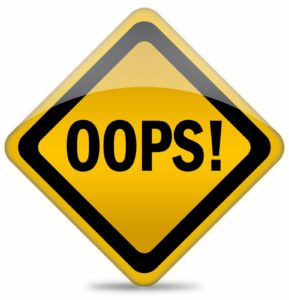
More challenging still is achieving good quality of expression, i.e. when the objective is to produce a translation where all loose and unclear wording is repaired so the text is well written and natural sounding throughout.
Translators report that MT programs such as Google Translate and Bing Translator typically produce some sentences that are excellent, some needing only minor editing, and a whole bunch needing considerable re-working or re-translating.
Translator forums are full of translators bemoaning the fact that bringing a MT text up to a consistent, professional standard of expression often takes more time than if they were tasked with translating the text from scratch.
The problem for the editor is that it isn’t just a matter of fixing awkward wording. Once they’ve done that there is often a mismatch in either phraseology/wording or writing style between their edited text and the good MT sentences they’ve left untouched.
The same word or term can end up being translated in different ways, which generally isn’t ideal. So they typically then have to review and tweak or re-write part of the otherwise pretty good MT text to ensure a natural flow and consistent style and wording throughout the text.
This is a lengthy task, and generally one few translators enjoy – boring, ungratifying and repetitive are terms I’ve seen used to describe it!
Which leads us to the conclusion …
There’s really no way round it:
Where guaranteed accuracy and good quality of expression is required this translation method really struggles, and human translation is preferable.
I would recommend against the machine translation plus post-editing method for any business documents where you need professional quality.
You would need a full accuracy check as well as a very thorough editing process, and this is a quite complex task for any editor. Often the final translation won’t match the quality an experienced professional translator would produce by translating the text from scratch.
What’s more, in most cases it won’t be faster or cheaper than human translation for a translation you can rely on and use commercially.
Machine translation + light post-editing in a nutshell
The good
– Generally cheaper and faster than human translation
The bad
– Can still contain translation errors
– Wording won’t be great
This method is best for
– Translations for information purposes only
Translation method 3: Human translation
Whenever a high quality translation is needed, ie one that’s fully accurate, well-worded and natural sounding, using a human translator is the way to go.
Producing this level of quality is not possible with straight machine translation, and as we’ve seen, is a complex, difficult and lengthy task with the PEMT method.
But it is precisely what professional human translators do all day, every day, with relative ease.
As always though, you need to use the right translator. Translation is a difficult skill, and few people actually have the ability to do it well.
I’ve discussed in other articles the skillset needed and translation process to be followed, but essentially you need to use an experienced, professionally qualified translator with a good track record of quality work, or a translation company that employs professional translators. Anything less and you’re gambling on quality.
With the right translator you can expect a high quality translation with excellent quality of expression that will be of publishable standard.
For this quality of translation there would typically be no disadvantage in terms of time and cost in using a professional human translator over the machine translation plus post-editing method, and the quality is likely to be noticeably superior.
However it does need to be recognised that, like everyone, human translators do sometimes make mistakes, and without a second translator review of the translation (as in our final method) there is always a low risk of inadvertent inaccuracy or omission.
In our company we refer to translations by a single professional translator as our budget professional translation service, and recommend these for the translation of non-critical business documents.
Human translation (with the right translator!) in a nutshell
The good
– Error-free, fully accurate translation
– Good quality of expression
The bad
– Small chance of inadvertent “human error”
This translation method is suitable for
– All purposes
Method 4: Human translation plus revision
Adding a review process to a human translation produces the highest level of translation quality, and is recognised as best practice. It also meets the requirements of translation-specific quality standard EN15038.
The method comprises an initial translation by a human translator, followed by a full review of that translation by a second translator. The review is designed to pick up any inadvertent errors made by the initial translator, confirm the translation is 100% accurate, and refine and “polish” the text.
So it is part safety check, part refinement of wording.
The translations produced by this method will be appropriate for all purposes, and they are what we refer to in our company as our quality-assured business translations.
They are particularly recommended for essential documents and whenever accuracy and quality of expression can’t be compromised. Being the highest quality level, this is the most expensive method of the four and requires the longest turnaround time.
Human translation + revision in a nutshell
The good
– Highest quality of translation
The bad
– More expensive and take longer
This method is ideal for
– All purposes, including publication
The four translation methods compared: quality vs speed vs cost
The key considerations for clients in their business translation projects are inevitably quality, time and cost.
We’ve seen how machine translation produces low quality, that this can be improved with human post editing, but is surpassed with human translation and even more so with human translation plus revision.
Unsurprisingly, this increase in translation quality is accompanied by similar increases in turnaround time and cost.
Here is a visual depiction of how this could be plotted.
And here is a summary of how the 4 methods compare against these three key criteria:
| Method | Quality | Turnaround | Cost |
|---|---|---|---|
| Machine translation | Low. Likely to contain errors and unclear and/or awkward wording. | Instant to very fast | Free to minimal |
| MT + light Post-editing | Medium. Understandable without being well written. May contain translation errors. | Reasonably fast | Low to medium |
| Human translation | High. Accurate and well written, but possibility of inadvertent translator error. | Slower | Higher |
| HT + Revision | Highest. Of publishable quality, suitable for any purpose. | Slowest | Highest |
When to use each type of translation
The four translation methods described here each have their merits and are suited to different requirements.
Selecting which one to use for a particular text is best governed by the level of quality you need in the translation.
Here are the rules of thumb we suggest you use:
- Free machine translation is ideal for simply getting the gist of a text.
- Commercial machine translation programs are probably only suited to large organisations with very large translation volumes in the same subject area.
- Machine translation plus light editing is excellent for “for information purposes only” translations where some unnatural and slightly awkward wording, and the risk of the odd mistranslation, can be tolerated.
- Human translators should be used whenever translation accuracy and good quality of expression is wanted.
- Machine translation plus post-editing generally won’t generate the same quality of wording an experienced professional translator will produce.
- Human translation plus revision addresses the possibility of inadvertent translator error and achieves the highest standard of expression, so is the recommended method for essential business documents and whenever excellent wording is desired.
Download this summary of the 4 translation methods.
Click to open. Then right click and save, or use the download icon.
Let us quote for your next translation project!
We can’t help you with machine translation or PEMT,
but are your ideal partner if you need high-quality translations
by the very best human translators.
We’ll deliver you high-quality work – guaranteed
Simply:
– use our translation quote form, or
– e-mail us the details.
We’ll be back to you asap.
Make sure you’re getting our Translation Tips e-mails!
Proven, highly practical and quick-read tips for achieving better translation results, direct to your inbox.
Great value for just 20 seconds of your time, once a fortnight. Sign up now, or read more here.
See the Key articles for clients list on our main blog page. Or start with these:
Matching your translation purpose to the right type of translation – for a great result, every time
What we mean by translation quality and a simple method for assessing it
Knowing when you need a technical translator – and when you don’t
Back to top | Pactranz blog | Pactranz home page

